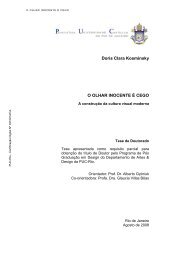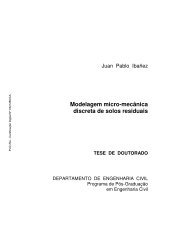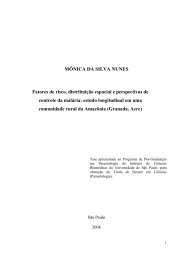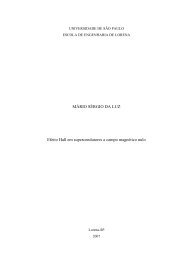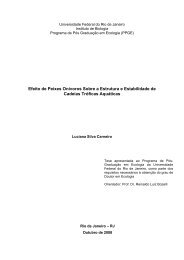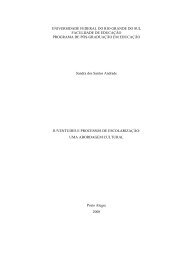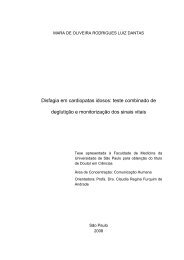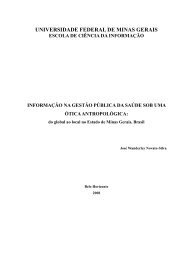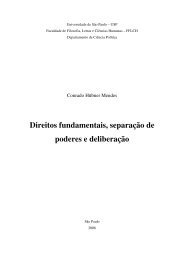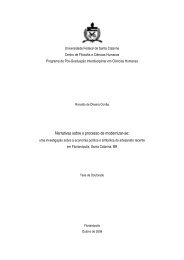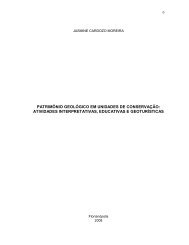Create successful ePaper yourself
Turn your PDF publications into a flip-book with our unique Google optimized e-Paper software.
226as organized by the Tree View software. However, the constitutionof these clusters diverged among strains, i.e. eachcluster harbor different <strong>gene</strong>s with different expression patterns.Balb-c Strain (Fig. 2a)*Cluster 1 comprised the IL-4 <strong>gene</strong> which was not modulatedremaining expressed at low levels during thymus development.Cluster 2 comprised MHC-I, RAG-2, IF-γ, IL-6, MHC-II,MMTV(SW), IL-1β, RAG-1, IL-2, IL-1α and TCRVβ <strong>gene</strong>s.We observed waves of transcriptional activity at 15–16 daysp.c. involving MHC-I, RAG-2, IF-γ, IL-6 and MHC-II. Theadult thymus overexpressed IF-γ, IL-6, MHC-II, MMTV(SW),IL-1β, RAG-1 and IL-2.Cluster 3 comprised IL-3, IL-2Rβ, TNF-β, IL-7 and GM-CSF <strong>gene</strong>s which displayed a peak of expression at 14 daysp.c. remaining unmodulated and at low levels during development.Taken together, the <strong>gene</strong>s of the cluster 2 were usuallymore transcribed at 16 days p.c. and in newborn pups andadults.CBA/J Strain (Fig. 2b)Cluster 1 comprised MHC-II, IL-6, MMTV(SW), IL-2Rβ andIL-7 <strong>gene</strong>s displaying a peak of expression in the late thymus(17 days p.c. and newborn pups).Cluster 2 comprised IF-γ, IL-1α, IL-3, IL-2, MHC-I, TNFβ,IL-1β, TCRVβ, RAG-2 and RAG-1 <strong>gene</strong>s and showed amore equilibrated transcriptional activity, i.e. waves of upand<strong>do</strong>wn-regulation distributed during development.Cluster 3 comprised IL-4 and GM-CSF <strong>gene</strong>s which, inrelation to the other strains, were not modulated remainingexpressed at low levels during thymus development.C57Bl/6 Strain (Fig. 2c)Cluster 1 also comprised only the IL-4 <strong>gene</strong> which was notmodulated, remaining expressed at low levels during thymusdevelopment.Cluster 2 comprised IL-1β, IL-3, TCRVβ, MMTV(SW),IL-1α, RAG-2 and TNF-β <strong>gene</strong>s. These <strong>gene</strong>s were usually<strong>do</strong>wn-regulated except MMTV(SW) and TNF-β which displayedtwo peaks of expression at 16 days p.c. and newbornpups.*Figure 2 is available at: www.rge.fmrp.usp.br/passos/RT_PCRCluster 3 comprised RAG-1, IL-6, IL-7, MHC-I, IL-2, IL-2Rβ, MHC-II, IF-γ and GM-CSF <strong>gene</strong>s. Taken together, the<strong>gene</strong>s of the cluster 3 were more transcribed displaying a peakof expression at 17 days p.c. except GM-CSF which wasoverexpressed in the early thymus (14–15 days p.c.) and<strong>do</strong>wn-regulated later.DiscussionOur aim was to compare the evolution of TCR Vβ8.1-Dβ2.1V(D)J rearrangements and transcription of several <strong>gene</strong>s importantin T-cell differentiation during the thymus ontogenyof normal inbred mouse strains. We observed that emergenceof V(D)J recombination and transcription of TCR βlocus differ among these strains (Fig. 1), strongly suggestingan effect of <strong>gene</strong>tic background as previously discussed[1, 2].T-cell differentiation occurs within the thymus and all developmentalstages are distinguishable by their expression ofcombination of CD cell-surface markers. The V(D)J recombinationof the TCRα/β and γ/δ segments is a central phenomenondefining the T-cell fate, which is mediated by therecombinase complex from RAG-1 and RAG-2 <strong>gene</strong>s andmodulated by several other <strong>gene</strong> products [3, 4].Transcriptional regulation studies have monitored expressionof RAG-1, RAG-2, transcription factors and cytokine<strong>gene</strong>s during T-cell development in vitro and in vivo. T-cellspecific transcription factors such as TCF-1, LEF-1, Sox-4,CREB and GATA-3 modulate the expression of several otherimportant <strong>gene</strong>s such as TCRs, RAG-1, IL-4 and CD4/CD8αmarkers [16]. Data obtained by reverse transcription-polymerasechain reaction (RT-PCR) with total thymocytes showedthat expression of RAG-1 begins at a high level and is thendevelopmentally <strong>do</strong>wn-regulated, and IL-2 and IL-4 are bothexpressed at a low levels [17].The mouse strains we studied displayed different expressionpatterns involving the 17 <strong>gene</strong>s assayed (Fig. 2). Thesefindings demonstrate that the RT-PCR method followed byhierarchical clustering can be used to visualize the effect of<strong>gene</strong>tic background on the expression profiling of the thymus.Moreover, associations between the expression data canbe established.Several studies using in vitro cultures of fetal liver cellsor fetal thymocytes have suggested that IL-7 signaling couldspecifically induce RAG-1 and RAG-2 and thus have an effecton TCR β rearrangements. Moreover, as thymocytes differentiatefurther, IL-7 becomes the <strong>do</strong>minant cytokine thatappears to serve as a proliferative agent before and after rearrangement,and possibly as a survival factor during rearrangement[5, 7].Clustering (Fig. 2) showed that the peak of IL-7 <strong>gene</strong> expressionoccurred before (Balb-c and C57Bl/6) or usually



